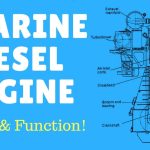How does an engine works?
How does the engine start up in the first place?
How does the reciprocating motion of the piston converts to rotary motion of the propeller?
How does the piston gains its momentum from?
How? When? Where? What? Who?
Ever came across your mind before?
We’ll provide you with the best, relevant answers as possible.
Firstly, if you want to know what is really going on inside the engine or
technically, the cylinder, click on the following image which will re-direct you
to an animation of a four-stroke engine cycle.
Note: Set the play speed to its minimal and just observe 1 cylinder will do!

What about 2-Stroke Engines?
2-Stroke Engine cycle in comparison to 4-stroke Engine:
| 2-Stroke Engine | 4-Stroke Engine |
| 2 strokes to complete 1 working cycle | 4 strokes to complete 1 working cycle |
| Air intake through scavenge ports | Air intake through suction valves |
| Low Speed Engines | High Speed Engines |
| Higher power | Lesser power |
| Expensive parts | Cheaper parts |
Advantages of 2-stroke Engines in comparison to 4-stroke engines:
| 1. No suction valves, hence simple construction. |
| 2. Have a high power-to-weight ratio (engine has twice as many combustions per second as a four stroke engine revolving at the same speed). |
| 3. Have the potential for about twice the power in the same size (twice as many power strokes per revolution). |
| 4. Lighter, and cost less to manufacture. |
Disadvantages of 2-Stroke Engines in comparison to 4-stroke engines:
| 1. Shorter lifespan as compared to four-stroke engines (parts wears out faster due to the lack of a lubrication system). |
| 2 . Require a mix of oil with the gas to lubricate the crankshaft, connecting rod and cylinder walls. |
| 3. Costly. |
| 4. Less fuel efficiency. |
| 5. Produce more pollution. |


